How to use find() in es6
In es6, find() is used to find the value of the first element in the array that meets the conditions through the callback function, the syntax is "array.find(function(...), thisValue)". find() will call a function execution for each element in the array. When an element in the array returns true when testing the condition, find() returns the element that meets the condition, and the execution function will not be called for subsequent values; If there are no matching elements, undefined is returned.

The operating environment of this tutorial: Windows 7 system, ECMAScript version 6, Dell G3 computer.
es6 Introduction to find()
The find() method returns the value of the first element of the array that passes the test (judged within the function).
The find() method calls a function execution once for each element in the array:
When the element in the array returns true when testing the condition, find( ) returns elements that meet the conditions, and subsequent values will not call the execution function.
If there is no matching element, return undefined
Syntax:
array.find(function(currentValue, index, arr),thisValue)
| Parameters | Description |
|---|---|
| function(currentValue, index,arr) | Required. The function that needs to be executed for each element of the array. Function parameters: Parameter description currentValue is required. The current element index is optional. The index value arr of the current element is optional. The array object to which the current element belongs |
| thisValue | is optional. The value passed to the function usually uses the "this" value. If this parameter is empty, "undefined" will be passed to the "this" value |
返回值:返回符合测试条件的第一个数组元素值,如果没有符合条件的则返回 undefined。
注意:
find() 对于空数组,函数是不会执行的。
find() 并没有改变数组的原始值。
基本使用
Array.prototype.find
返回第一个满足条件的数组元素
const arr = [1, 2, 3, 4, 5];
const item = arr.find(function (item) {
return item > 3;
});
console.log(item);//4如果没有一个元素满足条件 返回undefined
const arr = [1, 2, 3, 4, 5];
const item = arr.find(function (item) {
return item > 5;
});
console.log(item); //undefined返回的元素和数组对应下标的元素是同一个引用
const arr = [
{
id: 1,
name: '张三',
},
{
id: 2,
name: '李四',
},
{
id: 3,
name: '王五',
},
];
const item = arr.find((item) => item.name === '李四');
console.log(item);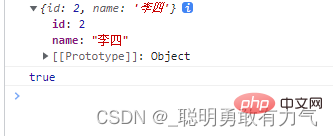
回调函数的返回值是boolean 第一个返回true的对应数组元素作为find的返回值
const arr = [
{
id: 1,
name: '张三',
},
{
id: 2,
name: '李四',
},
{
id: 3,
name: '王五',
},
];
const item = arr.find(function (item) {
return item.id > 1;
});
console.log(item);
回调的参数
当前遍历的元素 当前遍历出的元素对应的下标 当前的数组
const arr = [
{
id: 1,
name: '张三',
},
{
id: 2,
name: '李四',
},
{
id: 3,
name: '王五',
},
];
const item = arr.find(function (item, index, arr) {
console.log(item, index, arr);
});
find的第二个参数
更改回调函数内部的this指向
const arr = [
{
id: 1,
name: '张三',
},
{
id: 2,
name: '李四',
},
{
id: 3,
name: '王五',
},
];
const item = arr.find(
function (item, index, arr) {
console.log(item, index, arr);
console.log(this);
},
{ a: 1 }
);
如果没有第二个参数
非严格模式下 this -> window
const arr = [
{
id: 1,
name: '张三',
},
{
id: 2,
name: '李四',
},
{
id: 3,
name: '王五',
},
];
const item = arr.find(function (item, index, arr) {
console.log(item, index, arr);
console.log(this);
});
在严格模式下
不传入第二个参数 this为undefined 与严格模式规定相同
'use strict';
const arr = [
{
id: 1,
name: '张三',
},
{
id: 2,
name: '李四',
},
{
id: 3,
name: '王五',
},
];
const item = arr.find(function (item, index, arr) {
console.log(item, index, arr);
console.log(this);
});
稀疏数组find
find会遍历稀疏数组的空隙 empty
具体遍历出的值 由undefined占位
const arr = Array(5);
arr[0] = 1;
arr[2] = 3;
arr[4] = 5;
const item = arr.find(function (item) {
console.log(item);
return false;
});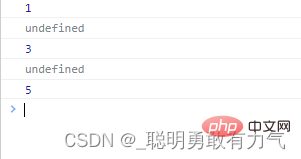
而ES5数组扩展方法forEach,map,filter,reduce,reduceRight,every,some 只会遍历有值的数组
find的遍历效率是低于ES5数组扩展方法的
find不会更改数组
虽然新增了元素 但是find会在第一次执行回调函数的时候 拿到这个数组最初的索引范围
const arr = [1, 2, 3, 4, 5];
const item = arr.find(function (item) {
arr.push(6);
console.log(item);
});
console.log(arr);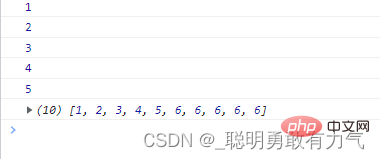
const arr = [1, 2, 3, 4, 5];
const item = arr.find(function (item) {
arr.splice(1, 1);
console.log(item);
});
console.log(arr);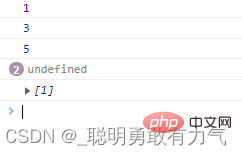
splice 删除对应项 该项位置不保留 在数据最后补上undefined
const arr = [1, 2, 3, , , , 7, 8, 9];
arr.find(function (item, index) {
if (index === 0) {
arr.splice(1, 1);
}
console.log(item);
});
delete
删除该项的值 并填入undefined
const arr = [1, 2, 3, , , , 7, 8, 9];
arr.find(function (item, index) {
if (index === 0) {
delete arr[2];
}
console.log(item);
});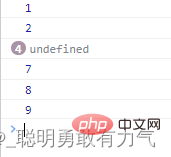
pop
删除该项的值 并填入undefined
const arr = [1, 2, 3, , , , 7, 8, 9];
arr.find(function (item, index) {
if (index === 0) {
arr.pop();
}
console.log(item);
});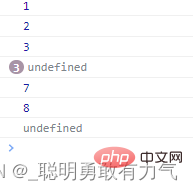
创建myFind
Array.prototype.myFind = function (cb) {
if (this === null) {
throw new TypeError('"this" is null');
}
if (typeof cb !== 'function') {
throw new TypeError('Callback must be a function type');
}
var obj = Object(this),
len = obj.length >>> 0,
arg2 = arguments[1],
step = 0;
while (step < len) {
var value = obj[step];
if (cb.apply(arg2, [value, step, obj])) {
return value;
}
}
step++;
return undefined;
};【相关推荐:javascript视频教程、编程视频】
The above is the detailed content of How to use find() in es6. For more information, please follow other related articles on the PHP Chinese website!

Hot AI Tools

Undresser.AI Undress
AI-powered app for creating realistic nude photos

AI Clothes Remover
Online AI tool for removing clothes from photos.

Undress AI Tool
Undress images for free

Clothoff.io
AI clothes remover

Video Face Swap
Swap faces in any video effortlessly with our completely free AI face swap tool!

Hot Article

Hot Tools

Notepad++7.3.1
Easy-to-use and free code editor

SublimeText3 Chinese version
Chinese version, very easy to use

Zend Studio 13.0.1
Powerful PHP integrated development environment

Dreamweaver CS6
Visual web development tools

SublimeText3 Mac version
God-level code editing software (SublimeText3)

Hot Topics
 1386
1386
 52
52
 How to implement an online speech recognition system using WebSocket and JavaScript
Dec 17, 2023 pm 02:54 PM
How to implement an online speech recognition system using WebSocket and JavaScript
Dec 17, 2023 pm 02:54 PM
How to use WebSocket and JavaScript to implement an online speech recognition system Introduction: With the continuous development of technology, speech recognition technology has become an important part of the field of artificial intelligence. The online speech recognition system based on WebSocket and JavaScript has the characteristics of low latency, real-time and cross-platform, and has become a widely used solution. This article will introduce how to use WebSocket and JavaScript to implement an online speech recognition system.
 WebSocket and JavaScript: key technologies for implementing real-time monitoring systems
Dec 17, 2023 pm 05:30 PM
WebSocket and JavaScript: key technologies for implementing real-time monitoring systems
Dec 17, 2023 pm 05:30 PM
WebSocket and JavaScript: Key technologies for realizing real-time monitoring systems Introduction: With the rapid development of Internet technology, real-time monitoring systems have been widely used in various fields. One of the key technologies to achieve real-time monitoring is the combination of WebSocket and JavaScript. This article will introduce the application of WebSocket and JavaScript in real-time monitoring systems, give code examples, and explain their implementation principles in detail. 1. WebSocket technology
 How to use JavaScript and WebSocket to implement a real-time online ordering system
Dec 17, 2023 pm 12:09 PM
How to use JavaScript and WebSocket to implement a real-time online ordering system
Dec 17, 2023 pm 12:09 PM
Introduction to how to use JavaScript and WebSocket to implement a real-time online ordering system: With the popularity of the Internet and the advancement of technology, more and more restaurants have begun to provide online ordering services. In order to implement a real-time online ordering system, we can use JavaScript and WebSocket technology. WebSocket is a full-duplex communication protocol based on the TCP protocol, which can realize real-time two-way communication between the client and the server. In the real-time online ordering system, when the user selects dishes and places an order
 How to implement an online reservation system using WebSocket and JavaScript
Dec 17, 2023 am 09:39 AM
How to implement an online reservation system using WebSocket and JavaScript
Dec 17, 2023 am 09:39 AM
How to use WebSocket and JavaScript to implement an online reservation system. In today's digital era, more and more businesses and services need to provide online reservation functions. It is crucial to implement an efficient and real-time online reservation system. This article will introduce how to use WebSocket and JavaScript to implement an online reservation system, and provide specific code examples. 1. What is WebSocket? WebSocket is a full-duplex method on a single TCP connection.
 JavaScript and WebSocket: Building an efficient real-time weather forecasting system
Dec 17, 2023 pm 05:13 PM
JavaScript and WebSocket: Building an efficient real-time weather forecasting system
Dec 17, 2023 pm 05:13 PM
JavaScript and WebSocket: Building an efficient real-time weather forecast system Introduction: Today, the accuracy of weather forecasts is of great significance to daily life and decision-making. As technology develops, we can provide more accurate and reliable weather forecasts by obtaining weather data in real time. In this article, we will learn how to use JavaScript and WebSocket technology to build an efficient real-time weather forecast system. This article will demonstrate the implementation process through specific code examples. We
 Simple JavaScript Tutorial: How to Get HTTP Status Code
Jan 05, 2024 pm 06:08 PM
Simple JavaScript Tutorial: How to Get HTTP Status Code
Jan 05, 2024 pm 06:08 PM
JavaScript tutorial: How to get HTTP status code, specific code examples are required. Preface: In web development, data interaction with the server is often involved. When communicating with the server, we often need to obtain the returned HTTP status code to determine whether the operation is successful, and perform corresponding processing based on different status codes. This article will teach you how to use JavaScript to obtain HTTP status codes and provide some practical code examples. Using XMLHttpRequest
 How to use insertBefore in javascript
Nov 24, 2023 am 11:56 AM
How to use insertBefore in javascript
Nov 24, 2023 am 11:56 AM
Usage: In JavaScript, the insertBefore() method is used to insert a new node in the DOM tree. This method requires two parameters: the new node to be inserted and the reference node (that is, the node where the new node will be inserted).
 JavaScript and WebSocket: Building an efficient real-time image processing system
Dec 17, 2023 am 08:41 AM
JavaScript and WebSocket: Building an efficient real-time image processing system
Dec 17, 2023 am 08:41 AM
JavaScript is a programming language widely used in web development, while WebSocket is a network protocol used for real-time communication. Combining the powerful functions of the two, we can create an efficient real-time image processing system. This article will introduce how to implement this system using JavaScript and WebSocket, and provide specific code examples. First, we need to clarify the requirements and goals of the real-time image processing system. Suppose we have a camera device that can collect real-time image data




